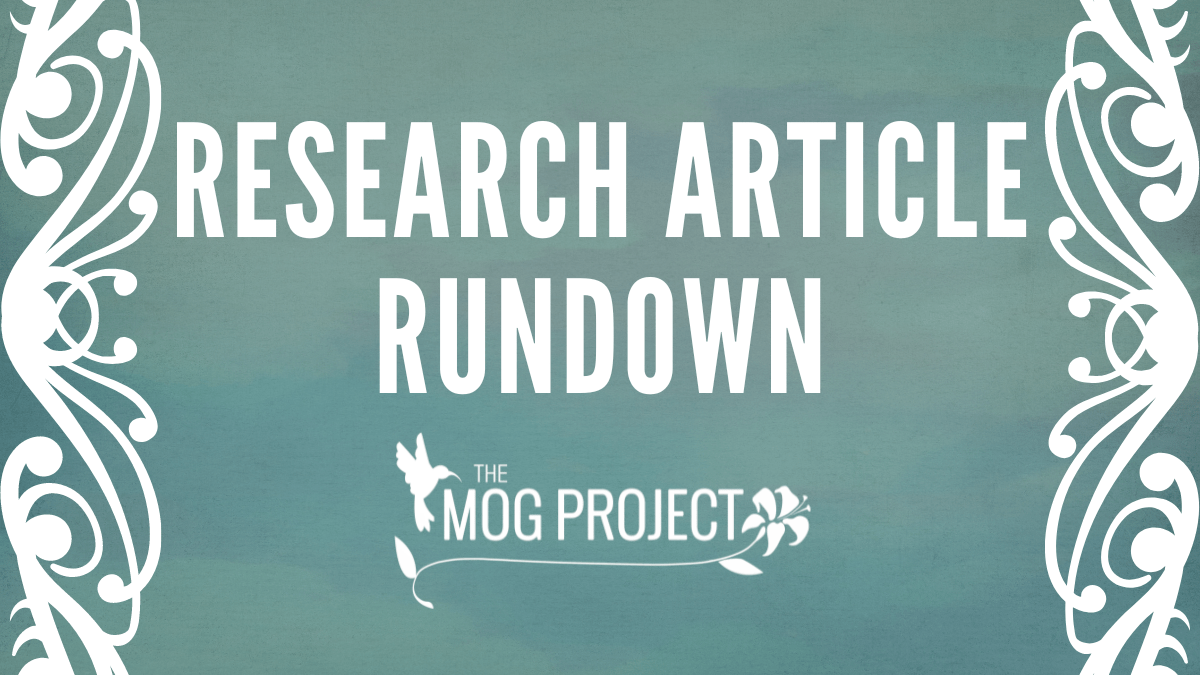In April, 2022, The MOG Project was joined by Professor Russell Dale, Dr. Sudarshini Ramanathan, and A/Professor Fabienne Brilot from the University of Sydney and Kids Neuroscience Centre, Westmead in a MOGcast series called MOGAD: Diagnosis, Management and Outcomes. On behalf of The MOG Project and the entire MOGAD community, we would like to thank Professor Russell Dale, Dr. Sudarshini Ramanathan, and A/Professor Fabienne Brilot for taking the time to help the community understand the diagnosis, management and outcomes of MOG Antibody Disease which includes: testing for the MOG antibodies in both serum and cerebrospinal fluid (CSF), the expanding clinical phenotypes of MOG-AD, investigations into relapses and all the incredible research that they continue to undertake for this rare neuroimmunological disorder.
You can view the entire MOGCast here.
As promised, we have collected 10 important questions that we did not have time to answer during the podcast which originated from our MOG-AD community. Professor Russell Dale, Dr. Sudarshini Ramanathan, and A/Professor Fabienne Brilot answered these questions for us and we are pleased to provide them below:
Questions and Answers
- How long should a patient be kept on a steroid taper regimen? What is the recommended time frame?
When a patient first presents with an episode of demyelination that is consistent with MOG-AD, the data suggests that they are often very responsive to treatment with steroids, with rapid clinical improvement. This treatment may be in the form of pulsed intravenous steroids for a few days followed by oral prednisone, or with oral prednisone from the start. There is emerging evidence that a slower prednisone taper in MOGAD that lasts at least three months and potentially longer, may reduce the rate of an early relapse. Although it is our practice to consider a cautious steroid taper over a few months, others do not support this. More research is needed to address this.
- What are some triggers for a relapse?
Some patients have features of a viral infection in the week or so prior to the clinical onset of a first presentation or relapse of MOG-AD. This could be in the form of a respiratory tract infection or gastrointestinal infection, for example. There are some reports of presentations being preceded by a vaccine in the week or two prior to clinical onset, although the population health benefits of vaccinations far outweigh the rare occurrence of these events. There is most often no identified trigger for relapses.
- Who should be involved in the clinical care of a patient who has MOG-AD?
Patients with MOG-AD often come under the care of an ophthalmologist or neurologist depending on the clinical features they present with (such as optic neuritis, transverse myelitis, or brain involvement). Depending on the clinical scenario, their care may be shared with immunologists as some patients with relapsing disease may require more sustained immunotherapy. Some patients who may struggle with a new diagnosis and the effect of this condition on their life may benefit from a team based approach which involves a neuropsychiatrist and/or a psychologist.
- Can children who’ve had ADEM or other presentations of the brain, go on to suffer learning difficulties at school?
- Can MOG-AD patients have other comorbidities? (e.g., other diseases and disorders). If so, what are some examples?
- What differentiates paediatric patients from adult patients who have MOG-AD? Who is likely to have the better outcome?
Children frequently present with ADEM, while optic neuritis is common in both children and adults. ADEM is quite rare in adults. Interestingly, apart from ADEM, we have noted that the clinical and radiological features of children with optic neuritis and transverse myelitis are quite similar to those of adults, and that treatment responses are also similar. While children may theoretically do better than adults as they might have fewer comorbidities, this of course still comes down to the severity of the clinical episode, the time to disease recognition and diagnosis, and the timing of appropriate immunotherapy.
- The literature seems to be mixed about MOG antibody titers. Why do some patients still have high MOG antibody titers but have never relapsed (monophasic course) and others are becoming negative and still relapsing?
This is an interesting topic which still needs work. There is evidence that looking at longitudinal antibody titres/end point dilutions/binding levels in a single patient shows that they often have more antibody binding at clinical onset or during relapses compared to when they are in disease remission. But some patients have prolonged intervals between relapses, with either sustained positive titres or they become seronegative for a period and then become seropositive at the next relapse. It would be unusual for a relapsing patient to be seronegative, and if this was the case, the timing of sample collection and its proximity to the relapse, the type of diagnostic assay used to detect the MOG antibodies in serum, and the type of concomitant immunotherapy that the patient is on, should all be taken into account
- When should a patient present to the emergency department or call their neurologist in terms of exhibiting signs of a relapse?
Patients should always come to get medical attention if they notice clinical deterioration or signs consistent with a relapse such as loss of vision, weakness or sensory changes, bladder dysfunction, or other concerning features. Clinicians would always want to investigate and act on new neurological deficits as early intervention reduces the extent of residual disability.
- If a patient is positive for the MOG antibodies, and goes on to have multiple relapses that are typical clinical presentations of MOG-AD but their blood work is persistently negative, would you still classify them as having MOG-AD?
As mentioned in question 7, it is unusual for a patient to relapse persistently with ongoing seronegative results. So, in such a case, the timing of sample collection and its proximity to the relapse, the type of diagnostic assay used to detect the MOG antibodies in serum, and the type of concomitant immunotherapy that the patient is on, should all be taken into account. And it is certainly important to keep an open mind with differential diagnoses as a patient can have more than one medical condition.
- How important is the doctor-patient relationship for the management and care of a MOG-AD patient considering it is a relatively new disease?
In any medical condition, the doctor-patient relationship is of critical importance. Good communication and developing a partnership is critical to ensure the patient understands the condition, their options, and implications of different pathways.
Key Takeaways from the MOGCast and questions answered in this blog
- A positive serum test on a live cell-based assay is vital for an accurate diagnosis of MOG-AD, as long as it fits the typical clinical picture and/or radiological findings are consistent with MOG-AD.
- Early research is being undertaken to understand if MOG antibody positivity in both serum and CSF is more commonly associated with a more severe and/or relapsing form of MOG-AD.
- The data suggests that patients who present with a demyelinating episode consistent with MOG-AD are often very steroid responsive with rapid clinical improvement. Emerging evidence supports a slow 3 months or potentially longer taper reduces the risk of early relapse. However, more research is needed to clarify this.
- It is unusual for a patient to relapse on a negative antibody result, however still possible. Things that need to be taken into consideration for a patient relapsing on a negative result include: timing of the sample collected, the assay that was used and treatment/s they are on. However, clinical judgement remains the key for these relapsing presentations.
- According to international and national data, patients who are relapsing tend to do better on treatment than no treatment.
- A clinical evaluation and an expedited MRI is vital during a suspected relapse but not always accessible. It’s up to the clinician to make a clinical judgement based on symptom onset and disability in a timely manner so that more damage is not accumulated.
- Yes, it’s time for MOG-AD to have its OWN international criteria. A manuscript is in revision internationally and will help with the diagnosis, clinical trials and better care of patients who have MOG-AD.
By Jenny Khazen, Australian Ambassador & Medical Professional Outreach Specialist
With contributions from Dr. Sudarshini Ramanathan, A/Prof. Fabienne Brilot and Prof. Russel Dale.






